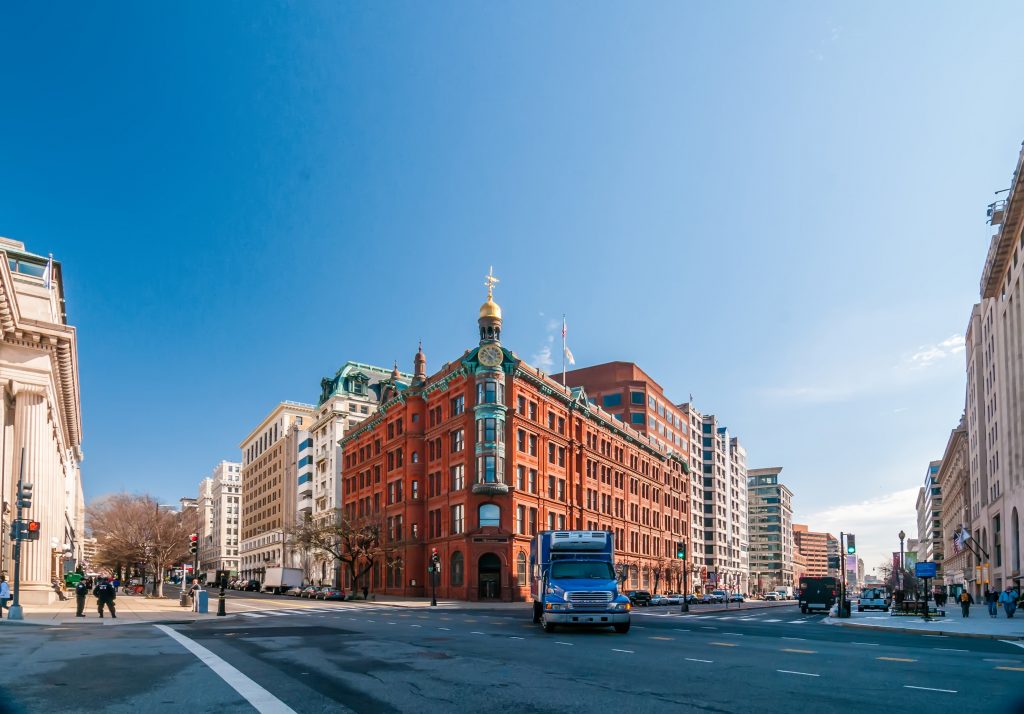Opportunity Zones (OZ) are designated geographic areas where investments are rewarded with a new set of federal tax breaks created as part of the 2017 Tax Cuts and Jobs Act (TCJA). The stated intent of the policy is to alleviate poverty in low-income neighborhoods by incentivizing private investments in designated “distressed” areas through various federal tax breaks. This policy brief provides an overview of how opportunity zones are designed and highlights some of the flaws of the policy, including the detrimental impact opportunity zones have on communities of color.
The Design of Opportunity Zones
Under the federal Opportunity Zones program, investors can qualify for various tax breaks on the capital gains income from investments in qualifying opportunity zones.
To qualify as an “opportunity zone,” an area has to meet the statutory criteria for a “low-income community,” either having at least a 20 percent poverty rate or a median income less than 80 percent of the median income in the closest metropolitan area (both metrics are based on the 2012-2016 American Community Survey data).[1] State governors have authority to elect the maximum number of eligible tracts in their states, thereby influencing where investors can qualify for tax subsidies.
The three tax breaks for qualifying investments are:
- Investors selling property and investing the resulting income in an Opportunity Zone fund can defer paying tax on the previously accumulated unrealized capital gains from that sale until 2026.
- If the investment is kept in an Opportunity Zone fund for at least five years, the previously accumulate unrealized capital gains will qualify for a lower effective tax rate. Rates are even lower for investments held for seven years or more. This is accomplished by excluding a portion of the gain from tax entirely. [1]
- New capital gains generated by Opportunity Zone investments are completely tax-free if they are held in the fund for at least 10 years.
Flaw 1: Opportunity Zones Don’t Incentivize New Investments in Truly Distressed Areas
The Opportunity Zones program claims “to bring investments, jobs, business expansion, and new business development” to economically distressed communities.[2] Fundamentally, the design of opportunity zones undercuts this stated intention. Several studies have demonstrated that investors make decisions about where to invest largely independent of tax incentives,[3] which means tax incentives like opportunity zones offer a windfall benefit for projects that would have occurred anyway. This is true in almost every instance; consensus estimates in the academic literature about the responsiveness of business decisions to taxes find that as many as 9 out of 10 hiring and investment decisions subsidized with tax incentives would have occurred even if the incentive did not exist.[4]
While this is likely true for most tax incentives, some states are acting in ways to guarantee this outcome for opportunity zones. For example, state officials in Maryland, when nominating census tracts to be eligible for the Opportunity Zone tax break, identified “distressed areas” based on where developers previously decided to invest in profitable projects that were already underway, rather than selecting “need-based” areas that wouldn’t otherwise attract those kinds of investments.[5]
To the extent the Opportunity Zones program may influence investor behavior, one likely impact would be to drive investors toward the most profitable projects (high-end condos, luxury hotels, etc.) rather than the ones that are more responsive to the direct needs of the current residents in these communities (for example, grocery stores or community centers). This is because the tax subsidy is significantly larger for highly-profitable ventures than for other types of projects.
Additionally, because opportunity zones are based on of median income, some areas qualify even though they are not truly distressed.[6] For example, several areas near college campuses qualify since median income tends to be lower due to concentrated populations of college students. Without explicit policy mechanisms to encourage investments that would be of greater benefit to current residents, opportunity zones are likely to reward projects tailored toward higher-income people and contribute to gentrification.
Flaw 2: Treasury Regulations and IRS Guidance for Opportunity Zones Are Inadequate to Ensure the Effectiveness of the Program
The regulations proposed by the U.S. Treasury Department are insufficient to ensure the benefits of the program flow to low-income communities. For instance, much of the program could incentivize projects outside of the designated opportunity zones; due to complex investment and asset tests that determine qualifying tax breaks, as little as 40 percent of the original investment in an opportunity zone could end up actually benefitting the designated area.[7]
Similarly, moves by the IRS to create greater transparency around opportunity zones are important but fall short of providing the data required to hold investors accountable for the impacts of their investments. The IRS proposal released in October 2019 would require Opportunity Zone funds “to disclose the employer identification numbers, census tract numbers, and assets of the businesses in which they invest, as well as the funds’ own structures and assets.”[8] However, there are no reporting requirements on economic data on such as job creation or poverty reduction.
Flaw 3: Opportunity Zones Will Profit from and Perpetuate America’s Historical Racism
The U.S. Department of Housing and Urban Development’s promotional website on opportunity zones displays the quote, “Revitalization doesn’t have a color or a party; it starts in the heart.” However, the “revitalization efforts” rewarded under this program certainly have racial implications related to who predominantly lives in the underserved communities being identified as ripe for investment, presumptions made as to why these communities are distressed, and the investors who stand to profit under the program.
Poverty has persisted in American cities because of the wealth and income disparities across races and therefore cannot be fixed without investing in equitable policies such as quality education and health care. Public policies relying on tax incentives for the wealthy have been rooted in the belief that communities of color are underserved because of a lack of capital or a lack of jobs. When in fact, communities of color are disenfranchised due to institutions that uphold structural racism such as segregation, redlining and discrimination in the housing market.[9] This is made clear in tax incentive policies like opportunity zones because poverty persists when wealthy investors are given power to exploit business opportunities in these communities rather than empowering the people in these communities by investing in them directly.
The Opportunity Zones program is not unlike many other economic benefit policies enacted since the 1970s that have failed to really benefit underserved communities who are majority people of color. Rather than bolstering social programs that promote equity such as SNAP and the EITC, the federal government has enacted very similar tax incentive programs that have failed time and time again. From Enterprise Zones[10] to New Market Tax Credits,[11] research has shown that these programs have had little to no effect on economic activity. The Opportunity Zones program is not structured in a way that could reasonably be expected to bring about different results compared to these earlier programs. Essentially, these programs do not always target disadvantaged communities, and in the cases when they do, the investments do not necessarily help current residents of the communities.
For example, opportunity zones could incentivize gentrification, a process whereby a neighborhood becomes too expensive for its long-term residents to live as costs—particularly rent—increase sharply.[12] According to a study by the Federal Reserve Bank of Philadelphia, on average 19 percent of the census tracts selected to qualify as opportunity zones in 29 major US cities are already undergoing gentrification. Although there is not simply one way to measure gentrification, it is usually defined as an area where rent and property values increase faster than the citywide average or when an area has a significant increase in the number of college-educated residents.
The residents most at risk of being priced out of their communities as new projects are developed are Black and Latino families.[13] For example, luxury home developments in historically Black neighborhoods in D.C. that qualify as opportunity zones have already had a gentrifying effect.[14] A study by the Institute on Metropolitan Opportunity shows that D.C. has the highest rate of displacement of low-income households in the country. This has heavy racial implications as Black families have been the most displaced; since 2000, white population growth in some D.C. neighborhoods has exceeded 200 percent.
In other words, no one should expect Opportunity Zone tax subsidies to change the economic and racial inequalities that led to these communities being underserved.
Conclusion
The Opportunity Zones program is fundamentally flawed and therefore unlikely to achieve the stated purpose of promoting greater economic well-being in disadvantaged areas. Rooted in a theory of change that is dubiously grounded in structurally racist ideas and false principles from supply-side economics, the program will benefit wealthy investors while communities in need see no direct benefits that lead to economic equity. Although the U.S. Treasury and the IRS continue to write regulations to prevent abuse of the opportunity zones, the program will likely provide no benefit to communities of color or have the negative effect of displacing them. A better economic policy would focus on public investments that serve communities like education, health, and other policies that lead to shared prosperity and that create equitable economic growth.
[1] U.S. Department of Treasury: Community Development Financial Institutions Fund, “Opportunity Zones Resources.” Available at: https://www.cdfifund.gov/Pages/Opportunity-Zones.aspx
[2] The White House Opportunity and Revitalization Council. Available at”. https://opportunityzones.hud.gov/thecouncil
[3] Glaxer, Amihai, “Everything you think you know about corporate tax incentives is wrong,” CityLab. February 25, 2019. Available at: https://www.fastcompany.com/90310500/everything-you-think-you-know-about-corporate-tax-incentives-is-wrong
[4] Peters, Alan and Peter Fisher. “The Failures of Economic Development Incentives.” Journal of the American Planning Association. Vol. 70, No. 1. Winter 2004. At 32.
[5] Ernsthausten, Jeff and Justin Elliot, “One Trump Tax Cut Was Meant to Help the Poor. A Billionaire Ended up Winning Big.” ProPublica, Available at: https://www.propublica.org/article/trump-inc-podcast-one-trump-tax-cut-meant-to-help-the-poor-a-billionaire-ended-up-winning-big
[6] Jacoby, Samantha, “Potential Flaws of Opportunity Zones Loom, as Do Risks of Large-scale Tax Avoidance,” Center on Budget and Policy Priorities. January 11, 2019. Available at: https://www.cbpp.org/research/federal-tax/potential-flaws-of-opportunity-zones-loom-as-do-risks-of-large-scale-tax
[7]. “For example, these regulations imply that a QOF could satisfy the substantially all standards with as little as 40 percent of the tangible property effectively owned by the fund being used within a qualified opportunity zone. This could occur if 90 percent of QOF assets are invested in a qualified opportunity zone business, in which 70 percent of the tangible assets of that business are qualified opportunity zone business property; and if, in addition, the qualified opportunity zone business property is only 70 percent in use within a qualified opportunity zone, and for 90 percent of the holding period for such property. Multiplying these shares together (0.9 × 0.7 × 0.7 × 0.9 = 0.4) generates the result that a QOF could satisfy the requirements of section 1400Z–2 under the proposed regulations with just 40 percent of its assets effectively in use within a qualified opportunity zone.” 84 Fed. Reg. 84 at 18670. Available at: https://www.govinfo.gov/content/pkg/FR-2019-05-01/pdf/2019-08075.pdf
[8] O’Neal, Lydia, “IRS Opportunity Zone Form Doesn’t Quell Transparency Concerns (2),” Bloomberg Tax, Available at: https://news.bloombergtax.com/daily-tax-report/irs-opportunity-zone-form-doesnt-assure-transparency-advocates?context=search&index=2
[9] Ajilore, Oulgbenga, “The Harvest of American Racism,” Center for American Progress, September 17, 2019. Available at: https://www.americanprogress.org/issues/economy/news/2019/09/17/474567/harvest-american-racism/
[10] Good Jobs First, “Enterprise Zones,” Good Jobs First, Available at: https://www.goodjobsfirst.org/accountable-development/enterprise-zones
[11] GAO, “New Market Tax Credit: Better Controls and Data Are Needed to Ensure Effectiveness,” Government Accountability Office, August 11, 2014. Available at: https://www.gao.gov/products/GAO-14-500
[12] Although there is not simply one way to measure gentrification, it is usually defined as an area where rent and property values increase faster than the citywide average or when an area has a significant increase in the number of college-educated residents. Ding, Lei and Peter Birke, “How Are Cities Leveraging Opportunity Zones for Community Development?” Federal Reserve Bank of Philadelphia, November 2019. Available at: https://philadelphiafed.org/-/media/community-development/publications/special-reports/identifying_opportunity_occupations/opportunity-zones.pdf?la=en
[13] Hill, Misha and Lorena Roque, “So-Called Opportunity Zones Provide Opportunity for Whom?” Institute on Taxation and Economic Policy. Available at: https://itep.org/so-called-opportunity-zones-provide-opportunity-for-whom/
[14] Brown, DeNeen L. “Pushed Out,” Washington Post. September 21, 2019. Available at: https://www.washingtonpost.com/dc-md-va/2019/09/21/shed-lived-this-historically-black-dc-block-years-now-she-was-being-pushed-out/?arc404=true





